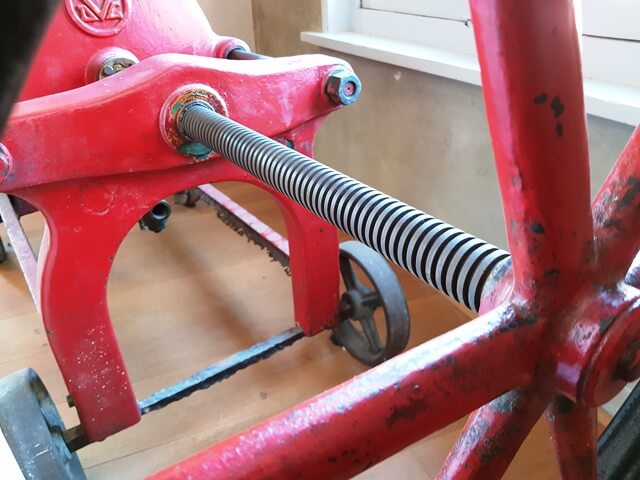Trapezoidal thread on the spindle
In today’s blog post we would like to take a closer look at the trapezoidal thread. What is a trapezoidal thread? What is a trapezoidal thread spindle? Why are trapezoidal threads mostly used as motion threads? Which manufacturing processes are common for trapezoidal threads? What are the core hole dimensions for the trapezoidal thread? Enjoy reading!


What is a trapezoidal thread spindle?
Trapezoidal thread spindles are used for manual and motor drive to convert rotary movements into linear ones.
What is a trapezoidal thread?
As the name suggests, the trapezoidal thread has an isosceles, trapezoidal thread profile.
Taps and dies with a trapezoidal thread bear the code letter Tr. The flank angle of the trapezoidal thread is 30 degrees. The trapezoidal thread is standardised according to DIN 103 and ISO 2901/2903.
Why are trapezoidal threads mostly used as motion threads?
Trapezoidal threads are preferably used as transmission threads because they can withstand high axial forces. This is because the threads are wider and the pitch is larger.
The trapezoidal thread is therefore used in different areas. Among other things in center lathes and feed screw lathes. But also in vices, clamps and angle clamps.
Manufacturing method for trapezoidal threaded spindles
In the manufacturing process, a distinction is made between, among other things, rolled and whirled versions. The rolled production process is carried out by cold forming and is non-cutting.
The rolled version has the advantage over the whirled version that it is more wear-resistant and robust. In addition, the flank surface is smoother.
Whirled thread spindles are a machining process that leaves a rough surface during manufacturing.
Did you know?
Historical anecdote about the trapezoidal thread drive:
The trapezoidal thread has been used as a driving force for centuries. Records show that the first filter presses were used in breweries in Germany as early as 1903 (see Teich 2000, p. 259)
During the brewing of beer or the production of wine, a so-called filter press or frame filter press was used for clarification.
The plates of this filter were pushed against each other with a manually operated trapezoidal thread spindle. The beer then flowed through the plates. The cloths between the plates ensured that the beer was clarified.
Historical anecdote about the trapezoidal thread drive:
The trapezoidal thread has been used as a driving force for centuries. Records show that the first filter presses were used in breweries in Germany as early as 1903 (see Teich 2000, p. 259)
During the brewing of beer or the production of wine, a so-called filter press or frame filter press was used for clarification.
The plates of this filter were pushed against each other with a manually operated trapezoidal thread spindle. The beer then flowed through the plates. The cloths between the plates ensured that the beer was clarified.


Core hole dimensions for the trapezoidal thread DIN 103
| Nominal diameter | Bolt diameter mm |
Core hole diameter nut mm |
| Tr 9 x 2 | 6,500 | 7,000 |
| Tr 10 x 2 | 7,500 | 8,000 |
| Tr 11 x 3 | 7,500 | 8,000 |
| Tr 12 x 3 | 8,500 | 9,000 |
| Tr 14 x 3 | 10,500 | 11,000 |
| Tr 16 x 4 | 11,500 | 12,000 |
| Tr 18 x 4 | 13,500 | 14,000 |
| Tr 20 x 4 | 15,500 | 16,000 |
| Tr 22 x 5 | 16,500 | 17,000 |
| Tr 24 x 5 | 17,500 | 19,000 |
| Tr 26 x 5 | 20,500 | 21,000 |
| Tr 28 x 5 | 22,500 | 23,000 |
| Tr 30 x 6 | 23,000 | 24,000 |
| Tr 32 x 6 | 25,000 | 26,000 |
| Tr 34 x 6 | 27,000 | 28,000 |
| Tr 36 x 6 | 29,000 | 30,000 |
| Tr 38 x 7 | 30,000 | 31,000 |
| Tr 40 x 7 | 32,000 | 33,000 |
| Tr 42 x 7 | 34,000 | 35,000 |
| Tr 44 x 7 | 36,000 | 37,000 |
| Tr 46 x 8 | 37,000 | 38,000 |
| Tr 48 x 8 | 39,000 | 40,000 |
| Tr 50 x 8 | 41,000 | 42,000 |
| Tr 52 x 8 | 43,000 | 44,000 |
| Tr 55 x 9 | 45,000 | 46,000 |
| Tr 60 x 9 | 50,000 | 51,000 |
| Tr 65 x 10 | 54,000 | 55,000 |
| Tr 70 x 10 | 59,000 | 60,000 |
| Tr 75 x 10 | 64,000 | 65,000 |
| Tr 80 x 10 | 69,000 | 70,000 |
| Tr 85 x 12 | 72,000 | 73,000 |
| Tr 90 x 12 | 77,000 | 78,000 |
| Tr 95 x 12 | 82,000 | 83,000 |
| Tr 100 x 12 | 87,000 | 88,000 |
| Tr 105 x 12 | 92,000 | 93,000 |
| Tr 110 x 12 | 97,000 | 98,000 |
| Tr 115 x 14 | 99,000 | 101,000 |
| Tr 120 x 14 | 104,000 | 106,000 |
| Tr 125 x 14 | 109,000 | 111,000 |
| Tr 130 x 14 | 114,000 | 116,000 |
| Tr 135 x 14 | 119,000 | 121,000 |
| Tr 140 x 14 | 124,000 | 126,000 |
| Tr 145 x 14 | 129,000 | 131,000 |
| Tr 150 x 16 | 132,000 | 134,000 |
| Tr 155 x 16 | 137,000 | 139,000 |
| Tr 160 x 16 | 142,000 | 144,000 |
| Tr 165 x 16 | 147,000 | 149,000 |
| Tr 170 x 16 | 152,000 | 154,000 |
| Tr 175 x 16 | 157,000 | 159,000 |
| Tr 180 x 18 | 160,000 | 162,000 |
| Tr 185 x 18 | 165,000 | 167,000 |
| Tr 190 x 18 | 170,000 | 172,000 |
| Tr 195 x 18 | 175,000 | 177,000 |
| Tr 200 x 18 | 180,000 | 182,000 |
| Tr 210 x 20 | 188,000 | 190,000 |
| Tr 220 x 20 | 198,000 | 200,000 |
| Tr 230 x 20 | 208,000 | 210,000 |
| Tr 240 x 22 | 216,000 | 218,000 |
| Tr 250 x 22 | 226,000 | 228,000 |
| Tr 260 x 22 | 236,000 | 238,000 |
| Tr 270 x 24 | 244,000 | 246,000 |
| Tr 280 x 24 | 254,000 | 256,000 |
| Tr 290 x 24 | 264,000 | 266,000 |
| Tr 300 x 24 | 274,000 | 276,000 |
(Source: Teich, M. (2000): „Bier, Wissenschaft und Wirtschaft in Deutschland 1800-1914: ein Beitrag zur deutschen Industrialisierungsgeschichte“. Publisher Böhlau, Wien.